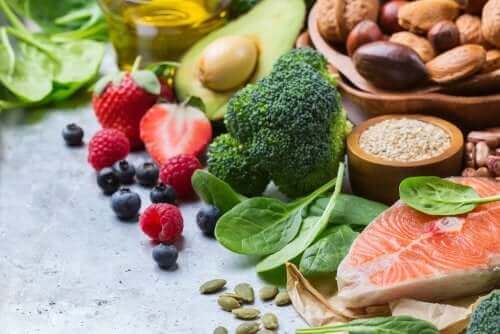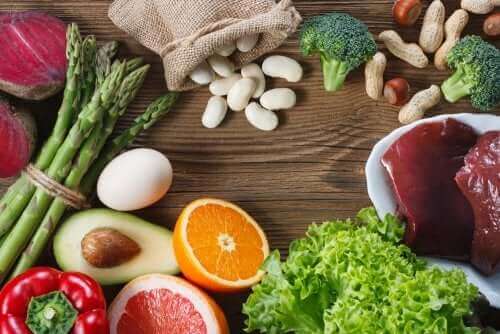The Best Foods to Eat During Menstruation

Before discovering the most beneficial foods to eat during menstruation, it’s important to understand the menstrual cycle. This cycle consists of four phases differentiated by the type of predominant hormones.
- Follicular phase. Begins just after the end of the period or menstruation. It’s a time in which estrogens are at a higher concentration. In contrast, FSH and LH are low. In addition, more estrogen increases insulin sensitivity and bone calcium absorption.
- Ovulation. This occurs in the middle of the cycle, approximately (day 14-16 depending on the duration of 28-35 days). It lasts between 16-24 hours and involves high levels of LH. Conversely, estrogens progressively decrease until reaching the next phase. In addition, body and vaginal temperature increase, as does the rate of metabolism.
- Luteal phase. It goes by this name because of the generation of the corpus luteum. It’s the result of the maturation of the follicle detached during ovulation. It also coincides with the increase of progesterone, reaching its maximum peak. In the event that fertilization hasn’t taken place due to pregnancy, then menstruation will follow. The luteal phase includes premenstrual syndrome. However, the levels of folates (vitamin B9) increase.
- Menstruation. It’s the beginning of the cycle that repeats itself throughout the woman’s fertile life. It lasts about 6-7 days and is characterized by bleeding, which involves the elimination of toxins, as well as some nutrients such as iron or folate. In addition, the content of certain vitamins and minerals decreases due to the hormonal and metabolic changes that occur. Therefore, it’s essential to replenish them through food. We’ll tell you more below.

The best foods to eat during menstruation
Iron, the basic nutrient among the foods you should eat during menstruation
You can find iron in both animal and plant-based foods, although the former is easier for the body to absorb. However, we can increase assimilation by eating it along with foods that are rich in vitamin C in the same meal. For example, lemon juice, peppers, oranges, tangerines, or kiwi. It’s also advisable to avoid dairy products and coffee, since they make absorption difficult.
It’s mainly present in red meat, mollusks (mussels, clams, cockles…) and legumes. Fish also provide iron.
Green leafy vegetables
They’re rich in magnesium and also in folic acid, so encouraging their consumption at this stage helps reduce menstrual cramps and the characteristic headaches. In addition, folate is key in case you want to get pregnant.
The recommendation is to incorporate them in at least one main meal per day, especially raw. You can eat them in a salad or make a green shake with other vegetables and spices. This group includes lettuce, corn salad, arugula, endive, celery, spinach, chard, cabbage, and broccoli.
Foods rich in calcium
Normally, the values of this mineral are directly related to magnesium, since they’re antagonistic. In addition, as levels drop, swelling and fluid retention is greater. It even increases the risk of fracture and osteoporosis. Therefore, it’s essential to cover the recommended doses in order to prevent complications.

Fruits, vegetables and spices, other of the most beneficial foods during menstruation
As we’ve commented before, menstruation is a detoxification stage, therefore, you need to include antioxidants in your diet. You can find them mainly in brightly colored fruits and vegetables like pumpkin, bell pepper, sweet potato, tomato, carrot, grapes, watermelon, etc.). Green tea and spices such as turmeric or ginger are also sources of antioxidants.
In summary, following a varied, vegetable-based diet during menstruation is key to feeling better and replenishing all the nutrients that are lost due to the physiological processes generated at this stage. You can even reduce the discomfort.
Before discovering the most beneficial foods to eat during menstruation, it’s important to understand the menstrual cycle. This cycle consists of four phases differentiated by the type of predominant hormones.
- Follicular phase. Begins just after the end of the period or menstruation. It’s a time in which estrogens are at a higher concentration. In contrast, FSH and LH are low. In addition, more estrogen increases insulin sensitivity and bone calcium absorption.
- Ovulation. This occurs in the middle of the cycle, approximately (day 14-16 depending on the duration of 28-35 days). It lasts between 16-24 hours and involves high levels of LH. Conversely, estrogens progressively decrease until reaching the next phase. In addition, body and vaginal temperature increase, as does the rate of metabolism.
- Luteal phase. It goes by this name because of the generation of the corpus luteum. It’s the result of the maturation of the follicle detached during ovulation. It also coincides with the increase of progesterone, reaching its maximum peak. In the event that fertilization hasn’t taken place due to pregnancy, then menstruation will follow. The luteal phase includes premenstrual syndrome. However, the levels of folates (vitamin B9) increase.
- Menstruation. It’s the beginning of the cycle that repeats itself throughout the woman’s fertile life. It lasts about 6-7 days and is characterized by bleeding, which involves the elimination of toxins, as well as some nutrients such as iron or folate. In addition, the content of certain vitamins and minerals decreases due to the hormonal and metabolic changes that occur. Therefore, it’s essential to replenish them through food. We’ll tell you more below.

The best foods to eat during menstruation
Iron, the basic nutrient among the foods you should eat during menstruation
You can find iron in both animal and plant-based foods, although the former is easier for the body to absorb. However, we can increase assimilation by eating it along with foods that are rich in vitamin C in the same meal. For example, lemon juice, peppers, oranges, tangerines, or kiwi. It’s also advisable to avoid dairy products and coffee, since they make absorption difficult.
It’s mainly present in red meat, mollusks (mussels, clams, cockles…) and legumes. Fish also provide iron.
Green leafy vegetables
They’re rich in magnesium and also in folic acid, so encouraging their consumption at this stage helps reduce menstrual cramps and the characteristic headaches. In addition, folate is key in case you want to get pregnant.
The recommendation is to incorporate them in at least one main meal per day, especially raw. You can eat them in a salad or make a green shake with other vegetables and spices. This group includes lettuce, corn salad, arugula, endive, celery, spinach, chard, cabbage, and broccoli.
Foods rich in calcium
Normally, the values of this mineral are directly related to magnesium, since they’re antagonistic. In addition, as levels drop, swelling and fluid retention is greater. It even increases the risk of fracture and osteoporosis. Therefore, it’s essential to cover the recommended doses in order to prevent complications.

Fruits, vegetables and spices, other of the most beneficial foods during menstruation
As we’ve commented before, menstruation is a detoxification stage, therefore, you need to include antioxidants in your diet. You can find them mainly in brightly colored fruits and vegetables like pumpkin, bell pepper, sweet potato, tomato, carrot, grapes, watermelon, etc.). Green tea and spices such as turmeric or ginger are also sources of antioxidants.
In summary, following a varied, vegetable-based diet during menstruation is key to feeling better and replenishing all the nutrients that are lost due to the physiological processes generated at this stage. You can even reduce the discomfort.
All cited sources were thoroughly reviewed by our team to ensure their quality, reliability, currency, and validity. The bibliography of this article was considered reliable and of academic or scientific accuracy.
- Lara Briden. (2019). Cómo mejor tu ciclo menstrual. Ed. Greenpeak.
- Angeli, A; Lainé, F; Lavenu, A; Ropert, M; Lacut, K; Gissot, V et al. (2016). Joint Model of Iron and Hepcidin During the Menstrual Cycle in Healthy Women. AAPS J, 18 (2): 490-504.
- Lainé F, Angeli A, Ropert M, Jezequel C, Bardou-Jacquet E, Deugnier Y et al. (2016). Variations of hepcidin and iron-status parameters during the menstrual cycle in healthy women. Br J Haematol, 175(5): 980-82.
- Petkus DL, Murray-Kolb LE, Scott SP, Southmayd EA, De Souza MJ. (2019). Iron status at opposite ends of the menstrual function spectrum. J Trace Elem Med Biol., 51: 169-75.
- Muneyvirci-Delale O, Nacharaju VL, Altura BM, Altura BT. (1998). Sex steroid hormones modulate serum ionized magnesium and calcium levels throughout the menstrual cycle in women. Fertil Steril, 69(5): 958-62.
- Dullo P y Vedi N. (2008). Changes in serum calcium, magnesium and inorganic phosphorus levels during different phases of the menstrual cycle. J Hum Reprod Sci, 1;(2): 77-80.
- Mumford SL, Browne RW, Schliep KC, Schmelzer J, Plowden TC, Michels KA et al. (2016). Serum Antioxidants Are Associated with Serum Reproductive Hormones and Ovulation among Healthy Women. J Nutr, 146(1): 98-106.
- Michels KA, Wactawski-Wende J, Mills JL, Schliep KC, Gaskins AJ, Yeung EH et al. (2017). Folate, homocysteine and the ovarian cycle among healthy regularly menstruating women. Hum Reprod, 32(8): 1743-50.
This text is provided for informational purposes only and does not replace consultation with a professional. If in doubt, consult your specialist.








